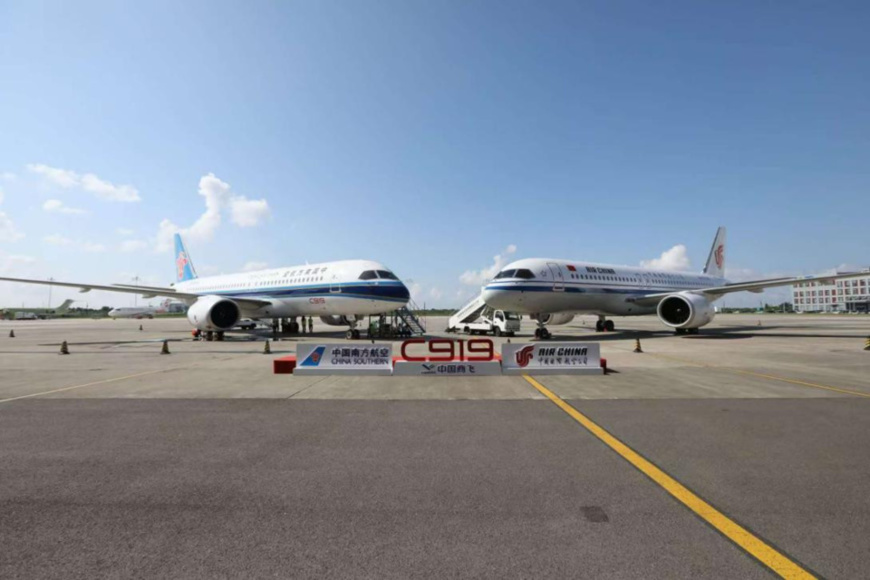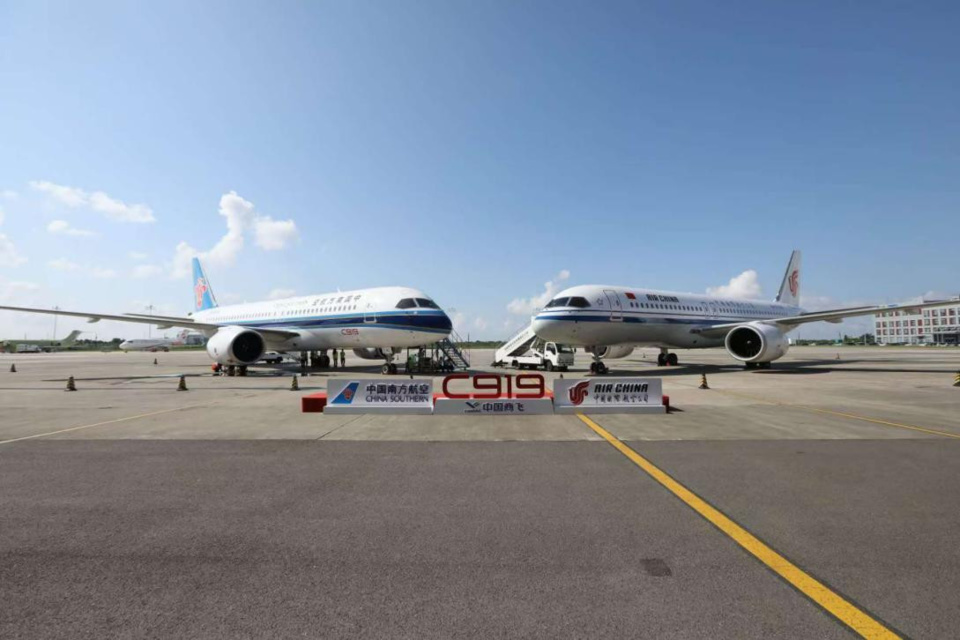By Yan Bing, He Yichen, Hua Yiran

Air China and China Southern Airlines both receive their first C919 aircraft at the Commercial Aircraft Corporation of China final assembly center in Shanghai's Pudong district, Aug. 28. (Photo by Hua Siqing)
At 11:23 am on Aug, 29, an Air China C919 aircraft from Shanghai, with the registration number B-919X, landed at the Beijing Capital International Airport.
On the previous day, Air China and China Southern Airlines both received their first C919 aircraft at the Commercial Aircraft Corporation of China (COMAC) final assembly center in Shanghai's Pudong district. This marked that the country's first domestically produced large passenger aircraft has entered a new phase in multi-user operations.
The first C919 aircraft was delivered to China Eastern Airlines on Dec, 9, 2022. Since beginning commercial operations on May 28 last year, the C919 aircraft has maintained safe operation of 15 consecutive months. The C919 fleet now consists seven aircraft, it has completed more than 3,600 commercial flights with total flight time exceeds 10,000 hours, and carried over 500,000 passengers.
Such outstanding performance of the China-developed large passenger aircraft is exactly an epitome of the steady progress made by China's advanced manufacturing industry.
In the first half of this year, Air China and China Southern Airlines have successively announced to purchase 100 C919 aircraft from COMAC. The introduction of the C919 to the two airlines' fleets signifies that the aircraft has moved past the initial "zero-to-one" breakthrough of the first delivery, and is now entering a "one-to-many" phase of rapid adoption. It also marked a significant step forward in the large-scale commercial operation of the domestically-produced large aircraft.
It is reported that Air China has opted for an extended-range version of the C919, configured with 158 seats across two classes: eight in business and 150 in economy. China Southern Airlines selected the standard-range model, featuring a three-class layout with 164 seats, including eight in business, 18 in premium economy, and 138 in economy.
Both aircraft feature custom-designed cabin layouts, offering tailored seating arrangements and comprehensive in-seat power solutions. This configuration underscores a commitment to enhancing passenger comfort while maintaining operational versatility.
Compared to the basic model, the extended-range version has a larger maximum takeoff weight of 78.9 tons and engine thrust of 30,000 pounds, allowing for longer flights. It has a full payload range of 2,000 nautical miles, an increase of 700 nautical miles compared to the basic model, and a maximum range of 5 hours, an increase of 1.7 hours. These improvements allow it to better meet the demand of the market.
In addition, the development of the C919 plateau variant aircraft is gradually advancing. The plateau variant features a shortened fuselage and high-altitude modifications to meet the transportation requirements of high-altitude regions.
In addition to the orders from the three major airlines totaling over 300 aircraft, Hainan Airlines' subsidiaries, Suparna Airlines and Urumqi Air, have also placed orders for a total of 60 C919 aircraft. Suparna Airlines said that it will receive their first C919 aircraft in the fourth quarter of this year, becoming the world's first private airline to operate the C919.
Shortly after a public address announcement was made, the first C919 flight of Air China landed smoothly at Beijing Capital International Airport. During the flight, the aircraft was stable and quiet. Its spacious and bright cabin was covered by WiFi network throughout the journey.
Additionally, the aircraft was equipped with improved fixed headrests, improved armrests, multiple storage pockets, and illuminated seat numbers. Settled into these seats, passengers could enjoy a sense of homey comfort and convenience, despite being miles above the ground.
"Our domestically-produced aircraft C919 is an excellent model, and I am proud of it. I am also proud to be a pilot for the C919," said the captain of the Air China C919 flight.
Hu Zhenjiang, deputy administrator of the Civil Aviation Administration of China, said that the C919 has entered a new stage, from research and development, production, delivery, mass production, to fleet operation and multi-user operations.
Meanwhile, the C919 is also on a "fast lane" in the overseas market. COMAC first applied for certification from the European Union Aviation Safety Agency in 2019. After the C919's first commercial flight in May 2023 and a year of domestic flight mission, the process of the application has accelerated. In July this year, the European regulatory agency provided positive feedback after conducting an inspection of the C919 aircraft in Shanghai.
He Dongfeng, board chairman of COMAC, said that as the C919 continues to expand its operations and demonstrate its effectiveness, it will be delivered to more customers, operate on more routes, cover more regions, and serve more passengers. This will bring new vitality to China's and even the world's civil aviation industry.
On the previous day, Air China and China Southern Airlines both received their first C919 aircraft at the Commercial Aircraft Corporation of China (COMAC) final assembly center in Shanghai's Pudong district. This marked that the country's first domestically produced large passenger aircraft has entered a new phase in multi-user operations.
The first C919 aircraft was delivered to China Eastern Airlines on Dec, 9, 2022. Since beginning commercial operations on May 28 last year, the C919 aircraft has maintained safe operation of 15 consecutive months. The C919 fleet now consists seven aircraft, it has completed more than 3,600 commercial flights with total flight time exceeds 10,000 hours, and carried over 500,000 passengers.
Such outstanding performance of the China-developed large passenger aircraft is exactly an epitome of the steady progress made by China's advanced manufacturing industry.
In the first half of this year, Air China and China Southern Airlines have successively announced to purchase 100 C919 aircraft from COMAC. The introduction of the C919 to the two airlines' fleets signifies that the aircraft has moved past the initial "zero-to-one" breakthrough of the first delivery, and is now entering a "one-to-many" phase of rapid adoption. It also marked a significant step forward in the large-scale commercial operation of the domestically-produced large aircraft.
It is reported that Air China has opted for an extended-range version of the C919, configured with 158 seats across two classes: eight in business and 150 in economy. China Southern Airlines selected the standard-range model, featuring a three-class layout with 164 seats, including eight in business, 18 in premium economy, and 138 in economy.
Both aircraft feature custom-designed cabin layouts, offering tailored seating arrangements and comprehensive in-seat power solutions. This configuration underscores a commitment to enhancing passenger comfort while maintaining operational versatility.
Compared to the basic model, the extended-range version has a larger maximum takeoff weight of 78.9 tons and engine thrust of 30,000 pounds, allowing for longer flights. It has a full payload range of 2,000 nautical miles, an increase of 700 nautical miles compared to the basic model, and a maximum range of 5 hours, an increase of 1.7 hours. These improvements allow it to better meet the demand of the market.
In addition, the development of the C919 plateau variant aircraft is gradually advancing. The plateau variant features a shortened fuselage and high-altitude modifications to meet the transportation requirements of high-altitude regions.
In addition to the orders from the three major airlines totaling over 300 aircraft, Hainan Airlines' subsidiaries, Suparna Airlines and Urumqi Air, have also placed orders for a total of 60 C919 aircraft. Suparna Airlines said that it will receive their first C919 aircraft in the fourth quarter of this year, becoming the world's first private airline to operate the C919.
Shortly after a public address announcement was made, the first C919 flight of Air China landed smoothly at Beijing Capital International Airport. During the flight, the aircraft was stable and quiet. Its spacious and bright cabin was covered by WiFi network throughout the journey.
Additionally, the aircraft was equipped with improved fixed headrests, improved armrests, multiple storage pockets, and illuminated seat numbers. Settled into these seats, passengers could enjoy a sense of homey comfort and convenience, despite being miles above the ground.
"Our domestically-produced aircraft C919 is an excellent model, and I am proud of it. I am also proud to be a pilot for the C919," said the captain of the Air China C919 flight.
Hu Zhenjiang, deputy administrator of the Civil Aviation Administration of China, said that the C919 has entered a new stage, from research and development, production, delivery, mass production, to fleet operation and multi-user operations.
Meanwhile, the C919 is also on a "fast lane" in the overseas market. COMAC first applied for certification from the European Union Aviation Safety Agency in 2019. After the C919's first commercial flight in May 2023 and a year of domestic flight mission, the process of the application has accelerated. In July this year, the European regulatory agency provided positive feedback after conducting an inspection of the C919 aircraft in Shanghai.
He Dongfeng, board chairman of COMAC, said that as the C919 continues to expand its operations and demonstrate its effectiveness, it will be delivered to more customers, operate on more routes, cover more regions, and serve more passengers. This will bring new vitality to China's and even the world's civil aviation industry.
 Menu
Menu
 C919 enters new phase in multi-user operations
C919 enters new phase in multi-user operations
















